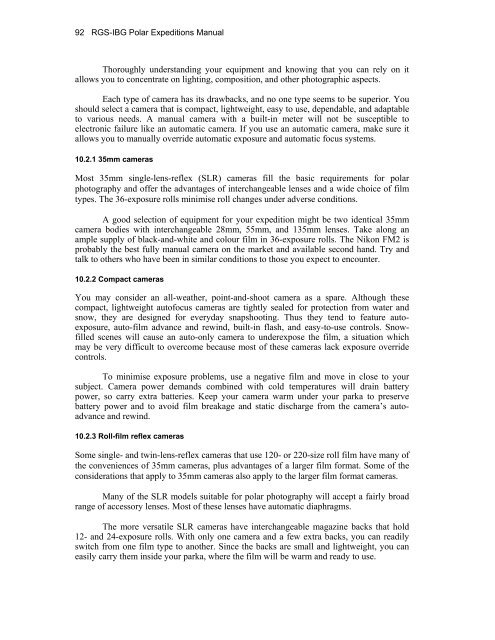Edited by Rachel Duncan 4th Edition ISBN 0-907649-91-2 London ...
Edited by Rachel Duncan 4th Edition ISBN 0-907649-91-2 London ...
Edited by Rachel Duncan 4th Edition ISBN 0-907649-91-2 London ...
You also want an ePaper? Increase the reach of your titles
YUMPU automatically turns print PDFs into web optimized ePapers that Google loves.
92 RGS-IBG Polar Expeditions Manual<br />
Thoroughly understanding your equipment and knowing that you can rely on it<br />
allows you to concentrate on lighting, composition, and other photographic aspects.<br />
Each type of camera has its drawbacks, and no one type seems to be superior. You<br />
should select a camera that is compact, lightweight, easy to use, dependable, and adaptable<br />
to various needs. A manual camera with a built-in meter will not be susceptible to<br />
electronic failure like an automatic camera. If you use an automatic camera, make sure it<br />
allows you to manually override automatic exposure and automatic focus systems.<br />
10.2.1 35mm cameras<br />
Most 35mm single-lens-reflex (SLR) cameras fill the basic requirements for polar<br />
photography and offer the advantages of interchangeable lenses and a wide choice of film<br />
types. The 36-exposure rolls minimise roll changes under adverse conditions.<br />
A good selection of equipment for your expedition might be two identical 35mm<br />
camera bodies with interchangeable 28mm, 55mm, and 135mm lenses. Take along an<br />
ample supply of black-and-white and colour film in 36-exposure rolls. The Nikon FM2 is<br />
probably the best fully manual camera on the market and available second hand. Try and<br />
talk to others who have been in similar conditions to those you expect to encounter.<br />
10.2.2 Compact cameras<br />
You may consider an all-weather, point-and-shoot camera as a spare. Although these<br />
compact, lightweight autofocus cameras are tightly sealed for protection from water and<br />
snow, they are designed for everyday snapshooting. Thus they tend to feature autoexposure,<br />
auto-film advance and rewind, built-in flash, and easy-to-use controls. Snowfilled<br />
scenes will cause an auto-only camera to underexpose the film, a situation which<br />
may be very difficult to overcome because most of these cameras lack exposure override<br />
controls.<br />
To minimise exposure problems, use a negative film and move in close to your<br />
subject. Camera power demands combined with cold temperatures will drain battery<br />
power, so carry extra batteries. Keep your camera warm under your parka to preserve<br />
battery power and to avoid film breakage and static discharge from the camera’s autoadvance<br />
and rewind.<br />
10.2.3 Roll-film reflex cameras<br />
Some single- and twin-lens-reflex cameras that use 120- or 220-size roll film have many of<br />
the conveniences of 35mm cameras, plus advantages of a larger film format. Some of the<br />
considerations that apply to 35mm cameras also apply to the larger film format cameras.<br />
Many of the SLR models suitable for polar photography will accept a fairly broad<br />
range of accessory lenses. Most of these lenses have automatic diaphragms.<br />
The more versatile SLR cameras have interchangeable magazine backs that hold<br />
12- and 24-exposure rolls. With only one camera and a few extra backs, you can readily<br />
switch from one film type to another. Since the backs are small and lightweight, you can<br />
easily carry them inside your parka, where the film will be warm and ready to use.

















